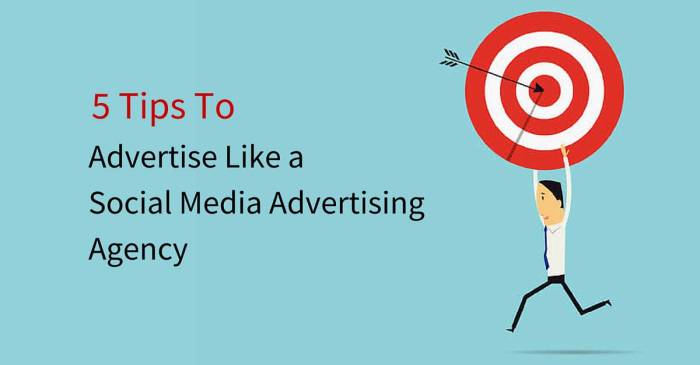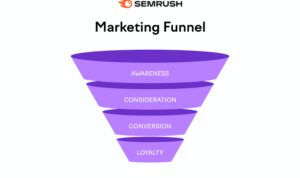Get ready to level up your social media game with these killer Social Media Advertising Tips. From choosing the right platforms to creating engaging content, this guide has got you covered.
Explore the world of social media advertising and learn how to drive brand awareness and customer engagement like a boss.
Importance of Social Media Advertising: Social Media Advertising Tips

In today’s digital age, social media advertising plays a crucial role in the success of businesses. With the majority of people spending a significant amount of time on platforms like Facebook, Instagram, and Twitter, it has become essential for brands to leverage these channels for reaching their target audience effectively.
Examples of Successful Social Media Advertising Campaigns
- Apple’s “Shot on iPhone” campaign: By showcasing stunning photos taken with iPhones by real users, Apple was able to create a sense of community and authenticity around their brand.
- Old Spice’s “The Man Your Man Could Smell Like” campaign: This humorous and engaging campaign featuring Isaiah Mustafa went viral, significantly increasing brand awareness and sales.
- Dove’s “Real Beauty Sketches” campaign: By focusing on self-esteem and body positivity, Dove’s campaign resonated with audiences worldwide, leading to increased engagement and positive brand sentiment.
Impact of Social Media Advertising on Brand Awareness and Customer Engagement
Social media advertising not only helps in increasing brand awareness but also plays a crucial role in fostering customer engagement. Through targeted ads, brands can reach the right audience with personalized content, leading to higher engagement rates and ultimately, conversions.
Choosing the Right Social Media Platforms

When it comes to social media advertising, choosing the right platforms can make or break your campaign. It’s essential to consider various factors to ensure you reach your target audience effectively.
Key Factors to Consider
- Demographics: Understand the demographics of each platform to align with your target audience.
- Engagement: Look at the level of engagement on different platforms to determine where your audience is most active.
- Goals: Consider your advertising goals and which platforms can help you achieve them best.
Advantages and Disadvantages
- Facebook:
- Advantages: Wide reach, detailed targeting options.
- Disadvantages: High competition, decreasing organic reach.
- Instagram:
- Advantages: Visual platform, high engagement among younger audiences.
- Disadvantages: Limited link options, highly competitive for visual content.
- Twitter:
- Advantages: Real-time updates, great for trending topics.
- Disadvantages: Limited characters, fast-paced feed.
Effective Platforms for Target Audiences
- For B2B Marketing:
- LinkedIn: Ideal for professional networking and reaching businesses.
- For Fashion Brands:
- Instagram: Perfect for visual showcasing of products and reaching a younger, trend-focused audience.
- For Local Businesses:
- Facebook: Helps target local audiences through geotargeting features.
Creating Engaging Ad Content
Creating engaging ad content is crucial in capturing the attention of your target audience and driving conversions. By incorporating visually appealing elements and crafting compelling ad copy, you can effectively communicate your message and encourage users to take action.
Strategies for Creating Visually Appealing Ad Content
Visual content plays a significant role in attracting and retaining the interest of social media users. To create visually appealing ad content, consider the following strategies:
- Use high-quality images and videos that are relevant to your brand and message.
- Experiment with different visuals, such as illustrations, infographics, and animations, to stand out in a crowded feed.
- Keep your design simple and uncluttered to ensure easy comprehension.
- Utilize eye-catching colors and fonts that align with your brand identity.
Tips for Crafting Compelling Ad Copy
Compelling ad copy is essential for conveying your message effectively and resonating with your target audience. Here are some tips for crafting compelling ad copy:
- Understand your audience’s pain points and address them directly in your copy.
- Create a sense of urgency or exclusivity to prompt immediate action.
- Use persuasive language and storytelling techniques to evoke emotions and connect with your audience.
- Keep your copy concise and impactful, focusing on the key benefits of your product or service.
Importance of Incorporating Multimedia Elements
Incorporating multimedia elements like images and videos in your social media ads can significantly enhance engagement and conversions. Visual content is more likely to grab attention and leave a lasting impression on users compared to text-only ads. By adding multimedia elements, you can create a more immersive and interactive experience for your audience, increasing the likelihood of them taking the desired action.
Targeting the Right Audience
When it comes to social media advertising, targeting the right audience is crucial for the success of your campaigns. By reaching the right people with your ads, you can increase engagement, drive conversions, and ultimately maximize your return on investment.
Defining and Segmenting Target Audiences, Social Media Advertising Tips
To define and segment your target audience effectively, start by analyzing your existing customer base. Look at factors such as demographics, interests, behaviors, and purchasing patterns to identify common characteristics among your most valuable customers. You can also use tools like Facebook Audience Insights or Google Analytics to gather data and create detailed buyer personas.
- Utilize social media analytics to track user interactions and preferences.
- Use A/B testing to experiment with different audience segments and optimize your targeting strategies.
- Consider creating lookalike audiences based on the characteristics of your existing customers to expand your reach.
Reaching a Specific Audience
There are various tools and methods you can use to reach a specific audience through social media advertising. Platforms like Facebook, Instagram, and LinkedIn offer advanced targeting options that allow you to narrow down your audience based on criteria such as age, location, interests, and more.
Remember to continuously monitor and adjust your targeting parameters to ensure you are reaching the right audience effectively.
- Utilize retargeting campaigns to reach users who have previously interacted with your brand.
- Collaborate with influencers or industry partners to tap into their existing audience and expand your reach.
- Experiment with different ad formats and messaging to resonate with different segments of your target audience.
Setting Clear Objectives and Goals
Setting clear objectives and goals for social media advertising campaigns is crucial for the success of any business. By defining what you want to achieve, you can focus your efforts, measure your progress, and make necessary adjustments along the way.
Importance of Setting Clear Objectives and Goals
- Setting clear objectives and goals helps businesses stay focused and aligned with their overall marketing strategy.
- It provides a roadmap for success and allows you to track your progress towards specific targets.
- Clear goals help in evaluating the effectiveness of your social media advertising campaigns and making informed decisions for future campaigns.
Examples of Measurable Goals
- Increase brand awareness by gaining 10,000 new followers on Instagram within three months.
- Generate 500 leads through Facebook ads in a month.
- Achieve a 5% conversion rate on Twitter ads by the end of the quarter.
Tracking and Analyzing Performance
- Utilize analytics tools provided by social media platforms to track key performance indicators (KPIs) such as reach, engagement, and conversions.
- Regularly monitor ad performance and analyze data to identify trends, strengths, and areas for improvement.
- Adjust your strategies based on the insights gathered to optimize the performance of your social media advertising campaigns.
Budgeting and Monitoring Ad Performance
Effective budgeting and monitoring ad performance are crucial aspects of social media advertising. By allocating your budget wisely and keeping a close eye on how your ads are performing, you can maximize your return on investment (ROI) and ensure that your campaigns are successful.
Tips for Budgeting Effectively
- Set clear budget goals based on your objectives and target audience.
- Allocate your budget across different platforms and ad formats to reach a wider audience.
- Monitor your spending regularly and make adjustments as needed to optimize performance.
- Consider testing different budget levels to see what works best for your campaigns.
Monitoring Ad Performance and Improving ROI
- Track key metrics such as click-through rates, conversion rates, and cost per acquisition to measure the success of your ads.
- Use tools like Facebook Ads Manager and Google Analytics to monitor ad performance in real-time.
- Analyze the data regularly and make adjustments to targeting, ad content, and budget allocation to improve ROI.
- Experiment with A/B testing to identify the most effective ad creatives and messaging.
Key Metrics to Track
- Impressions: The number of times your ad is displayed to users.
- Engagement: The level of interaction with your ad, including likes, comments, and shares.
- Conversion Rate: The percentage of users who take a desired action after seeing your ad.
- Return on Ad Spend (ROAS): The revenue generated for every dollar spent on advertising.





